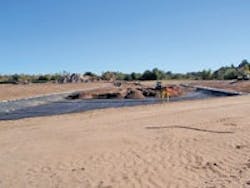About the author: Allen Hubbard is program administrator of the NPDES Storm Water Section of the Florida Department of Environmental Protection. Hubbard can be reached at [email protected] or 850.245.7606.
When it comes to storm water permitting for construction activities, the requirements can be complex. In Florida, two storm water permitting programs regulate construction activities: the state program under Part IV, Chapter 373, F.S.—most commonly referred to as Environmental Resource Permit—and the federal storm water program. Many local governments also have storm water permitting requirements.
The U.S. Environmental Protection Agency authorizes state agencies such as the Florida Department of Environmental Protection (DEP) to implement the National Pollutant Discharge Elimination System (NPDES) storm water permitting program, which regulates point source discharges of storm water runoff from certain construction sites that disturb one or more acres of land, and that discharge to surface waters of the state or into separate municipal storm sewer systems. Disturbances include clearing, grading and excavating large construction sites (disturbing five or more acres of land), and small construction sites (disturbing between one and five acres of land). When there is a common plan of development or sale that cumulatively disturbs one or more acres—such as a subdivision or office park—construction sites less than one acre also must obtain permits.
Generic Permit
The operator—the entity that owns or operates the project and has authority to control erosion, sediment and storm water to ensure permit compliance—of regulated construction sites must obtain an NPDES storm water permit and implement appropriate pollution prevention techniques to minimize erosion and sedimentation and properly manage storm water. To simplify obtaining a permit, the Florida DEP adopted under Rule 62-621.300(4), F.A.C., the Generic Permit for Storm Water Discharge From Large and Small Construction Activities (CGP), which is available on the Florida DEP’s website.
To obtain coverage under the CGP, the operator must submit a Notice of Intent (NOI) to the DEP, along with the $250 permit fee for small sites or $400 for large sites. The NOI also is available via the Florida DEP’s website.
When the construction activities at the site are completed as specified in the CGP, a Notice of Termination (NOT) must be submitted to the DEP to discontinue permit coverage. The CGP requires the development and implementation of a storm water pollution prevention plan (SWPPP). In part, the plan must include the following:
- • A site evaluation addressing how and where pollutants may be mobilized by storm water;
- • A site plan for managing erosion, sedimentation and storm water runoff;
- • Identification of appropriate erosion and sediment controls and storm water best management practices;
- • A maintenance and inspection schedule; a record-keeping process; and
- • Identification of storm water discharge locations.
Comprehensive Pollution Prevention
The SWPPP must ensure that sediment does not leave the site and discharges do not cause or contribute to violations of state water quality standards.
A comprehensive SWPPP includes both structural and non-structural controls for erosion and sediment as well as storm water management. Some commonly used structural controls for erosion and sediment can include the following:
- • Wet detention pond. A constructed water body designed to allow time for storm water pollutants to settle and for the storm water to be controlled to prevent offsite flooding;
- • Temporary sediment basins. Small basins used during construction to detain sediment-laden runoff from disturbed areas long enough for sediments to settle out and prevent turbidity in receiving waters;
- • Entrance/exit controls. Temporary controls, such as gravel, used to stabilize the entrances/exits to the site in order to prevent sediments from being transported onto paved roads by vehicles, known as “track-out;”
- • Silt fencing. A temporary erosion and sediment control used to prevent sediment dirt from entering waterways or leaving the site before bare soil is stabilized with vegetation; and
- • Berms. Temporary mounds of dirt with vegetation that physically prevent polluted runoff from leaving the site or entering nearby storm drain inlets and waters.
Non-structural controls can include the following:
- • Stabilization. Techniques such as sodding, seeding/mulching, and stone cover, which stabilize the bare soils and steep grades to reduce erosion;
- • Phased construction. Scheduling construction to occur during the dry season or minimizing the amount of land cleared at any one time; and
- • Good housekeeping. Techniques such as oil and fuel containment, spill prevention and cleanup, and street sweeping of “tracked-out” soils, which help prevent the contamination of storm water runoff.
To successfully obtain coverage under the NPDES Construction Generic Permit, the following steps must be completed:
- 1. Obtain a copy of the CGP.
- 2. Carefully read the permit language.
- 3. Develop and implement a SWPPP.
- 4. Complete an NOI online using the iNOI system or by submitting a hard copy NOI.
- 5. Submit the required fee.
- 6. Provide a copy of the NOI and acknowledgement letter to the MS4 if the construction occurs within its jurisdiction.
Permit coverage is granted 48 hours after the date that a completed NOI and permit fee is received by the Notices Center. Applicants will receive an acknowledgement letter granting permit coverage that includes a permit identification number. It is advisable to apply for coverage every five years if the construction activity extends beyond a five-year period, or submit a NOT to terminate coverage.
An Interactive Notice of Intent (iNOI) is available online to allow applicants to submit information electronically. Applicants who use iNOIs can complete, save, edit, pay for and submit NPDES storm water applications online. The use of iNOI is voluntary, but it will save applicants time and money.
Florida DEP’s website also provides more information on program coverage and requirements; useful links; and electronic versions of the rules, CGP, NOI, NOT and SWPPP guidance.
Download: Here
